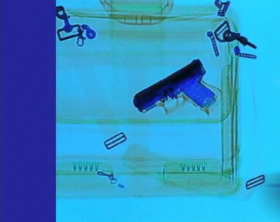Clik here to view.

Why do airport screeners miss guns in carry-ons?
During December of 2009, Farid Seif, a businessman from Houston, Texas, boarded a flight in Houston with a loaded handgun in his laptop case. He made it through security without a problem. Farid is not a terrorist. The gun is legal in Texas; he forgot to take it out of his laptop case before his travel. Farid realized the mistake when he got to his destination at the end of the trip.
Airport security at the Houston airport did not detect the gun. It would have been easily seen by a security screener through the scanner at the airport, but no one noticed it.
Homeland Security in the US routinely tests the ability to pass security screening with guns, bomb parts, and other forbidden materials, by sending people through undercover with material. The US government hasn’t released the figures officially, but the estimate is that 70% of these tests fail, meaning most of the time the undercover people are able to get through security, like Farid Seif, with objects that are supposed to be spotted.
People get used to the frequency of an event – Why do the security personnel notice the bottle of shampoo that is too large, but miss a loaded handgun? Research on attention gives a hint on why this might happen. It has to do with the expectation of how frequently an event does or does not happen.
They expect the shampoo — The security personnel miss the loaded handgun and bomb parts at least in part because they don’t encounter them frequently. The security person is working for hours at a time, watching people, and looking at the scanner screen. An expectation develops about how frequently certain violations occur. For example, he or she probably encounters too large containers of shampoo, or nail scissors fairly often, and so expects to see those, and then notices them when they appear. On the other hand, he or she probably does not encounter loaded handguns or bomb parts very often. Bellenkes (1997) conducted research these frequency expectations, and found that people create a mental model about how frequently an event is likely to occur. Unconsciously, that expectation affects how much they look for an event to occur, which affects how much attention they pay to looking for the event.
You can watch an ABC news clip on the Farid Seif incident here.
And for those of you who like to read the research: Bellenkes, A. H., Wickens, C. D., & Kramer, A. F. (1997). Visual scanning and pilot expertise: the role of attentional flexibility and mental model development. Aviation, Space, and Environmental Medicine, 68(7), 569-579.
